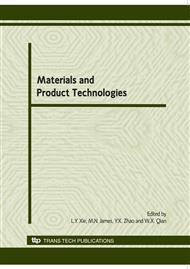[1]
D. Kececioglu: Nuclear Engineering and Design, Vol. 19 (1972), p.259.
Google Scholar
[2]
F.J. Witt: Pressure Vessel and Piping Technology - A Decade of Progress (1985).
Google Scholar
[3]
D. Kececioglu and J. Zhang: Proceedings Annual Reliability and Maintainability Symposium (1998).
Google Scholar
[4]
N.A. Siddiqui and S. Ahmad: Marine Structures, Vol. 14 (2001), p.331.
Google Scholar
[5]
Z. M. He, H. T. Loh and M. Xie: International Journal of Fatigue, Vol. 29 (2007), p.245.
Google Scholar
[6]
A. U. Efren and M. Torgeir: International Journal of Fatigue, Vol. 29 (2007), p.444.
Google Scholar
[7]
H.Y. Wang, N. H. Kim and Y.J. Kim: Transactions of the ASME, Vol. 128 (2006), p.919.
Google Scholar
[8]
Z. Guede, B. Sudret and M. Lemaire: International Journal of Fatigue, Vol. 29 (2007), p.1359.
Google Scholar
[9]
R. B. Sghaier, C. Bouraoui, R. Fathallah, et al: International Journal of Fatigue, Vol. 29 (2007), p.209.
Google Scholar
[10]
S. Tanaka, M. Ichikawa and S. Akita: Engineering Fracture Mechanics, Vol. 20 (1984), p.501.
Google Scholar
[11]
A.S.R. Murty, U.C. Gupta and A.R. Krishna: Int. J. Fatigue, Vol. 17 (1995), p.85.
Google Scholar
[12]
K. Ni and S.K. Zhang: Reliability Engineering and System Safety, Vol. 68 (2000), p.153.
Google Scholar
[13]
L. Y. Xie:International Journal of Pressure Vessels and Piping, Vol. 76 (1999), p.267.
Google Scholar
[14]
Y.S. Petryna, D. Pfanner, F. Stangenberg, et al: Reliability Engineering and System Safety, Vol. 77 (2002), p.253.
DOI: 10.1016/s0951-8320(02)00058-3
Google Scholar
[15]
S.W. Raudenbush and A.S. Bryk: Thousand Oaks, CA: SAGE Publications (2002).
Google Scholar
[16]
H. Pham: Int. J. Performability Engineering, Vol. 1 (2005), p.145.
Google Scholar
[17]
T. Tanaka: Proc. Fatigue 84, Vol. 2, (1984).
Google Scholar
[18]
C.R. Sohar, A. Betzwar-Kotas, C. Gierl, et al: International Journal of Fatigue Vol. 30 (2008), p.1137.
Google Scholar


